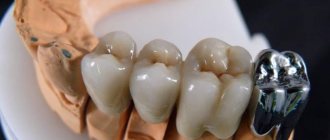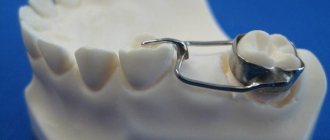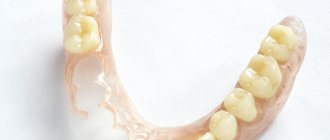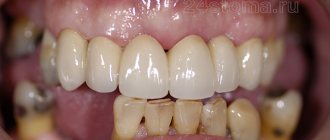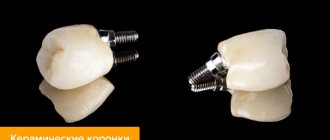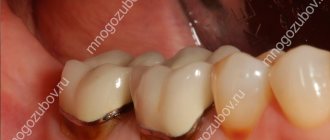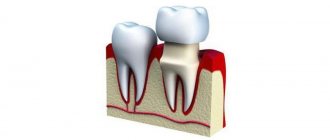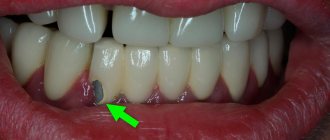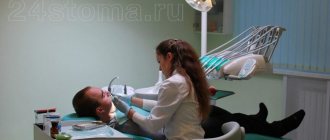- Work examples
- Questions and answers
- Stock
- Reviews
Modern dentistry offers a large number of different types of prostheses for restoring damaged teeth - the doctor selects the necessary design for each patient. Many patients have heard about telescopic prostheses, but do not quite understand what they are - in this article we will try to explain how telescopic prosthetics differs from conventional ones.
There are removable and non-removable (bridges, implants) dentures. Telescopic crowns are removable. Despite the fact that permanent structures, due to their name, may seem more durable, telescopic fastening of a denture in the oral cavity can last a very long time and provide a complete replacement of a lost tooth.
Why are dentures on telescopic crowns recognized as the most comfortable among removable structures?
Article navigation
- What are the features of the system
- The main indications for the installation of such prostheses
- How the system is designed and attached
- Types of telescopic crowns
- How are dentures made?
- Why choose a telescopic system
- How to care for dentures on “telescopes”
- Estimated cost of prosthetics
- An alternative to telescopic structures
- FAQ
Question for a specialist
Many patients strongly associate removable dentures with grandma’s false jaws, which need to be placed in a glass at night.
But today such an idea is outdated: not only should such structures not be kept in a humid environment outside the oral cavity, but they also have more comfortable analogues. In terms of aesthetics and convenience, prostheses mounted on telescopic crowns are the leaders. Today, such products are increasingly preferred by both the older generation and young people who are faced with the serious problem of tooth loss. Read about in what cases such prosthetics are recommended and what telescopes have to do with it in today’s material.
Minuses
Design disadvantages include:
- all supporting teeth must be corrected to install the prosthesis, since it is necessary to ensure sufficient space between them;
- difficulty in manufacturing, when even a minimal error cannot be made;
- on teeth with short crowns that have an inclined position and have abrasion of the second or third degree, such prostheses cannot be installed;
- when a metal crown is installed, it can be visible in the supragingival part (usually a special cap is used to hide such defects);
- the need for daily maintenance of the structure (cleaning and processing);
- when installing a crown on an implant, its breakage requires correction of the entire system;
- the need for multiple measurements before installation;
- quite high cost.
The main indications for the installation of such prostheses
Today, dentists use telescopic crowns if there are the following indications:
- loss of a large number of teeth: the prosthesis can replace several adjacent elements,
- the poor condition of the remaining units: that is, it is obvious that they will soon have to part with. After their loss, the design can be adjusted.
However, installation of such systems is not possible in all cases. Among the contraindications are the inclined position of the teeth, their abrasion of degrees 2 and 3, and individual intolerance to the materials of the product.
Indications and contraindications
A telescopic (primary and secondary) metal crown is indicated in the following cases:
- restoration of aesthetics and functionality;
- partial, complete edentia, the presence of units with a large affected area that need to be restored.
Contraindications are:
- pathological abrasion of enamel;
- the periodontium is in a neglected state and requires preliminary treatment;
- turning the side supports is impossible for a number of reasons;
- incorrect positioning of teeth and other anomalies of units planned for use as supporting ones.
Some of the contraindications are relative. Once obstacles have been removed, the system can be used for installation.
How the system is designed and attached
A prosthesis with telescopic crowns belongs to the clasp type, where the base is a metal frame. The orthopedic system includes 2 components:
- fixed part: represented by a crown resembling a thimble in shape. It is firmly attached to the supporting element using medical cement. Some sources and experts also call it a telescopic system if the structure is attached to implants. However, it is still most correct to consider this term specifically in relation to removable dentures, because a denture on implants is a completely different technology,
- removable part: in fact, the clasp prosthesis itself, into which a second crown with a “pit” is inserted, that is, a recess.
When connecting the parts, the second is put on the first, implementing the principle of a telescope. Thus, the product is firmly fixed. The removable part of the system can be removed from the mouth without much effort.
What is the structure of the prosthesis?
Telescopic crowns have two parts:
- A non-removable part in the form of a metal cap installed on the supporting tooth using cement. An implant can also be used to attach such a cap. The shape of the cap resembles a thimble.
- The prosthesis itself, which is removed, can be bridge-like or clasp with a metal-ceramic crown built into it.
The parts of the crowns are put on each other, approximately in the same way as a telescope. This promotes secure and efficient fastening. If necessary (for example, for correction or cleaning), the removable part is removed.
Types of telescopic crowns
Telescopic type crowns come in different shapes:
- cylindrical: the walls of the removable and non-removable parts are located parallel. This causes mutual sliding and traction is difficult to maintain. Suitable exclusively for teeth without periodontal pathologies. Extremely difficult to manufacture, therefore rarely used,
- conical: used for any indication for removable prosthetics. Due to the shape, they fit more tightly to each other, while taking off and putting on the prosthesis is quite easy - you don’t have to worry about skewing or jamming. During manufacturing, the individual angle of the cone is taken into account so that the removable part does not fly off randomly. This is possible due to viscous food or tongue, if serious errors were made in the production of the product.
It is not recommended to remove the structure too often, especially since this is not necessary. It is enough to do this once every 2-3 months to perform hygiene procedures.
PROSTHETICS WITH 6 OSSTEM IMPLANTS FROM RUB 200,000.
Complex implantation Osstem (South Korea) with delayed loading after 4-6 months.
Call now or request a call
What do dentists say?
Experts believe that installing telescopic prostheses is the most optimal solution for patients who are afraid to undergo implantation or cannot afford it due to the high cost or the presence of pathologies.
It is very important that such prostheses are installed only by a highly qualified specialist, because the manufacture of these structures is very painstaking work.
Such products contribute to a durable installation and reduce the load by distributing it evenly.
You can place such structures on healthy teeth, having previously ground them to fit the crown cavity. Teeth that are losing stability are fixed thanks to these products.
How are dentures made?
The telescopic crown of the tooth and the frame of the structure are made of palladium, gold, and cobalt-chromium alloys - ideally, both parts of the system should be made of the same material. The use of precious metals increases the cost of the product, but it ensures higher strength and also eliminates the risk of allergic reactions.
On a note! The latest word in dentistry is the use of galvanic technology. The structures are made from an alloy of base metals or zirconium dioxide, and gold is applied to the outside. The surface is covered with composites.
If telescopic crowns are recommended, the fabrication and installation steps may take more than a month in total. The process includes:
- history taking and examination: the doctor finds out the condition of the patient’s teeth, bite characteristics, allergic status and other nuances. The most important stage is the selection of supporting elements. The dentist will have to assess whether they can withstand the load. Errors in selection are fraught with loosening of elements and their further loss,
- production of the structure: first, impressions are taken from each jaw, from which dental technicians make a model. Then the blank is tried on in the patient’s mouth and adjustments are made. Next, the workpiece is again sent to the laboratory, where it is brought to perfection,
- preparation of supporting elements: if necessary, they are treated. Then the orthopedist grinds down the teeth and installs permanent crowns. After this, the telescopic crowns of the removable part are fixed.
Don't know what type of prosthetics to choose?
We will help in the selection, advise where to read more information and compare types of prosthetics.
Consultation with an orthopedic doctor in Moscow clinics is free! Call now or request a call
Working hours: from 9:00 to 21:00 - seven days a week
The production of such products is a complex and labor-intensive task, requiring highly qualified specialists. Even small deviations from technology can lead to negative consequences. In addition, the system is quite expensive, so the patient expects to receive a truly high-quality product that will be a worthy alternative to removable dentures.
It usually takes no more than 3 days to make an internal crown. The removable part requires a longer period - up to 4 weeks. How long it will take to prepare the abutment teeth depends on their condition.
Types and materials used
In removable dental prosthetics, special durable alloys that are not susceptible to oxidation are used for the manufacture of structures. It can be zirconium dioxide or an alloy of base metals. The crown can be covered with gold or other noble metal.
If possible, try to make both parts of the prosthesis from a homogeneous material. The materials used in production should not pose a risk to the patient’s health and should not oxidize while in the mouth.
Why choose a telescopic system
Among the undoubted advantages of such systems, experts note the following points:
- reliable fastening: the telescopic crown ensures complete immobility of the structure and eliminates the possibility of its falling out,
- uniform distribution of pressure on the supporting units when chewing: this prevents injury to the gums and has a good effect on periodontal tissues,
- accessibility of the spaces between the teeth when removing the prosthesis: allows you to fully perform hygiene procedures,
- the possibility of adjusting the products: this may be necessary if other teeth are lost,
- absolute aesthetics: thanks to the hidden fastening system, the prosthesis looks as natural as possible,
- strength: do not have open moving elements that could be broken.
Separately, it is worth mentioning the comfort of wearing such structures. They do not put pressure on the root of the tongue, so they do not cause a gag reflex. Dryness in the mouth is also not a threat, since the products do not close the salivary ducts. Another plus is the absence of a negative impact on diction.
Like any orthopedic solutions, telescopic systems are not without their drawbacks. The main one is the gradual atrophy of the jaw bone, which ceases to receive a full chewing load. This is a common disadvantage, characteristic of all prosthetic products.
Another disadvantage of telescopic structures is their high cost compared to other removable dentures. This is explained by the need to make 2 crowns for each abutment tooth. The exact amount will depend on the material of the product and the number of crowns.
How to care for dentures on “telescopes”
The products can be worn around the clock; they do not need to be removed at night. Caring for a prosthesis is simple, you just need to follow a number of rules:
- the removable part is periodically removed from the oral cavity and placed for disinfection in a soda-saline solution for 10-15 minutes. You can also use special solutions that are sold in pharmacies. It is important to understand that such a prosthesis is not completely removable, but conditionally removable, that is, it does not need to be removed too often; the entire system can be “lost”
- In normal times, hygiene procedures are carried out using the usual means: only pastes with abrasive particles that can damage the surface of the product are prohibited. It is recommended to use an irrigator, which will perfectly remove product residues from under the prosthesis,
- If the prosthesis needs to be removed for a long period of time, it should be cleaned, dried and stored in a plastic container at room temperature. Do not place the product in the refrigerator or keep it near a heat source - this will lead to its deformation.
Every six months it is necessary to visit the dentist in order to be able to identify possible problems in time and correct the design.
“I used an acrylic prosthesis for two years - during this time I experienced a lot of inconvenience, and especially when eating. In addition, the rigidity of acrylic constantly interfered. On the advice of the doctor, I installed a clasp prosthesis on telescopic crowns. I felt the difference immediately. I got used to it very quickly and now I hardly feel it. Almost like natural teeth!” Valentina, from correspondence on the dental forum
REPROSTHETICS WITH ACRYLIC PROSTHETICS - RUB 200,000.
Re-prosthetics with an acrylic bridge on a metal frame (all included) up to 12 units.
Save RUR 30,000. Call now or request a call
A telescopic dental crown and denture can theoretically last up to 10 years. However, practice shows that the actual period reaches a maximum of 4 years. After this time, the adhesive force of the crowns dries up, and they no longer fit tightly to each other.
Care
- There is no need to remove the structure before going to bed.
- The denture must be removed twice a day to perform oral hygiene and clean the structure from food debris and plaque.
- During the first time after installation, while you are getting used to the prosthesis, you should remove the structure in front of a mirror and over something soft to prevent chipping if the prosthesis accidentally falls.
- After eating, rinse your mouth with water.
- Check the function of the structure by visiting your dentist regularly.
Estimated cost of prosthetics
A prosthetic device on telescopic crowns is a fairly expensive option for removable prosthetics. The exact cost of manufacturing and installing the structure will depend on a number of factors, including the number of “voids” in the dentition, the material of artificial crowns, and the pricing policy of the dental center. So, one such crown can cost up to 20 thousand rubles. The cost of a prosthetic device will vary from 50 to 150 thousand - the more missing teeth, the higher the price.
Prices
| Service | Price |
| Consultation + treatment plan | For free |
| Telescopic crown | from 19,350 ₽ |
| Telescopic prosthesis | from 34,550 ₽ |
Expert of the article you are reading: Tseryabina Marina Anatolyevna Therapist
26 years
Clinical experience
Otradnoe
st. Khachaturyan, 7
+7 +7
Free consultation with this specialist
An alternative to telescopic structures
What can modern dentistry offer if a prosthesis on “telescopes” is not suitable for you for some reason? There are other methods of restoring teeth:
- removable products with clasps: seriously inferior to telescopic systems in aesthetics,
- clasp products with attachments (micro-locks): a good option, but not suitable if you have few teeth,
- nylon structures: inferior in terms of service life. In addition, they cannot be corrected in case of tooth loss,
- installation of implants: recognized as the best possible alternative, but much more expensive.
The choice of a specific method largely depends on the characteristics of the clinical picture, including the number of lost teeth and the financial capabilities of the patient. You need to understand that the best solution that will restore the appearance and full functionality of the dentofacial apparatus, as well as stop the atrophic processes in the jaw bone tissue, is dental implantation.
Beam fixation system
Following the locking fastenings and telescopic fixation, the beam fixation system, or the Rumpel-Schroeder-Dolder system, continues the ideology of the matrix-matrix design. This time, a beam acts as a patrix, extending over the alveolar process from the coronal part of one tooth to the other, and the corresponding matrix is located on the inner surface of the removable denture.
An important advantage of the “beam” is that it is a permanent splint, which is why it connects the remaining teeth located in different segments of the dentition, increases their stability and gives them the opportunity to perceive greater pressure, and also creates conditions for reliable fixation of the prosthesis on this very “beam” "
The beam can be placed almost anywhere, except, of course, in a diagonal position. In this case, it can be frontal, sagittal, frontosagittal or arched, combining all three sections of the dentition. It can also differ in shape and be ellipsoidal, rectangular or, for example, pear-shaped in cross section. The most functionally acceptable and durable will be the arched one, however, the clinical picture is not always observed when the position of the supporting teeth allows them to be connected to the creation of a large “beam”, but such a beam also requires strong periodontal tissue of these teeth, as well as a larger number of them. At the same time, it is illogical to unite closely spaced teeth with a “beam,” while telescopic fixation would be a better alternative, for example.
Undoubtedly, such a system cannot always be used, it is rather cumbersome, difficult to manufacture and has an adverse effect on the cost of the prosthesis, but if there are indications for it, it will certainly be the best option, since it will be most gentle on the periodontium of the remaining teeth, while at the same time providing a reliable fixation and high functional qualities.
FAQ
QUESTION: Good afternoon! I've been allergic since childhood. Is it dangerous for me to have telescopic dentures? Irina V., Saratov ANSWER: In general, various metals are used in such prostheses, including alloys containing nickel. If you are allergic to these materials, then this system will not suit you.
QUESTION: How do clasp prostheses on telescopes differ from conventional clasp prostheses? Nick, Moscow ANSWER: In the method of fastening. The removable clasp device is equipped with clasps for fixation on the supporting teeth. Telescopically installed on special double crowns. That is, they are already moving into the category of conditionally removable and are fixed much better. But again, they are not suitable for everyone - you need to consult a doctor.
QUESTION: Hello! I only have four of my teeth left. I want to install a telescopic prosthesis. How much is it? Ekaterina, Magnitogorsk ANSWER: It is not a fact that with so many teeth its installation is even possible. But if the doctor makes such a decision, then the total cost will include the price of 8 crowns (two for each tooth). The exact amount will depend on the materials used.
Author: Vasin Yu. A. (Thank you for your help in writing the article and the information provided)
Magnetic fixation system
I understand the technical part; it is not difficult to understand how the magnetic fixation system works. And this technical part is quite simple - poles with opposite charges attract, poles with equal charges repel.
In any removable prosthetics, it is necessary that the prosthesis be attracted to the tissues of the prosthetic bed, and accordingly repelled from the opposite side, which can be the prosthesis from the second jaw.
In order for the prosthesis to be attracted to the tissues of the prosthetic bed, one pole with a certain charge must be placed under these tissues, which is performed surgically by implanting magnetic implants, and the pole with the opposite charge must find its place in the prosthesis itself.
But similarly charged poles can also be used as a fixation system. In this case, magnets with the same charge are placed in both removable dentures for both jaws. As a result, pushing them away from each other will contribute to pressing and therefore better retention of both prostheses on the tissues of the prosthetic bed.
The article was written by N.A. Sokolov. especially for the OHI-S.COM website. Please, when copying material, do not forget to provide a link to the current page.


